Home - Arcade games - T.L.L.
T.L.L. (Tornado Low Level)
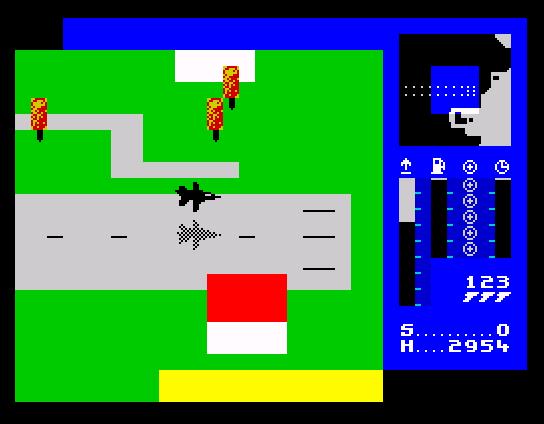
- Release year: 1984
- Publisher: Vortex Software
- Author: Costa Panayi
- ZXDB archive entry at Spectrum Computing
Background
I've never been an afficionado of flight sims, but when T.L.L. came out following the success of the entertaining Android 2, with game author Costa Panayi's programming kudos growing by the game, I knew it'd be worth a go. Also, the lack of a keyboard overlay indicated that it was almost certainly more arcade than flight sim.
Advertising for T.L.L. was bold but not particularly detailed and contained no screenshots - often an occurrence with many games-still-in-development.
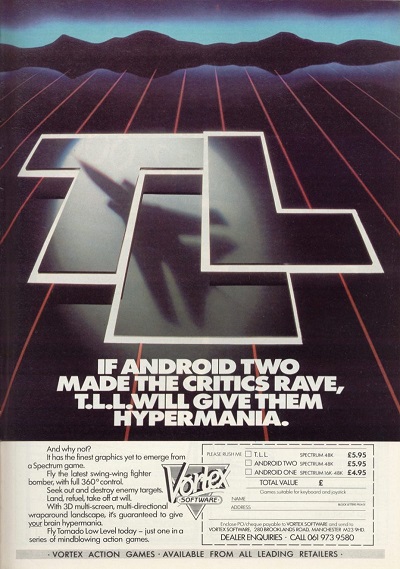
It's clear if you're familiar with Android 2 that T.L.L. is an extension of the minimalist, mainly-attributes graphic style - and in fact in this Sinclair User interview Costa does say that Android 3 was under consideration - but presentation aside, it's obvious that T.L.L. is a different type of game, altogether (cue obligatory Airplane quote/impersonation).
I didn't bother with a pic of the loading screen (it's basically just the letters, like on the advert), but there's a initial surprise at the start of loading the game:
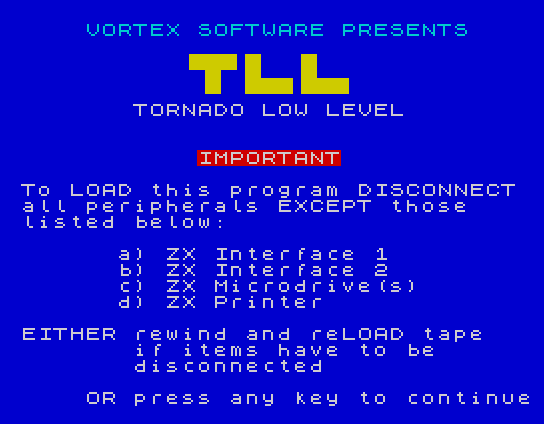
Well I suppose it's better than one of those F.A.C.T. warnings, but I was slightly surprised that a 1984 game explicitly denied the player a Kempston Joystick option. Although to be fair, I'm sure it's MUCH easier to play using the keyboard.
The game
You may know already, or may have guessed, but in this game you fly your Tornado plane around a 3D multi-directional scrolling map, with the aim of destroying FIVE bases. Each base appears in the game as a small target/circle and their placements vary. You destroy the bases by flying your plane very low over them (hence the 'L.L.' part of the title - I suppose otherwise it'd just be called 'T.').
At the start of each game you're shown a map with the locations of the bases. The map is wraparound but is quite small, so even if you forget where they are, they're usually not too hard to find during your flight.
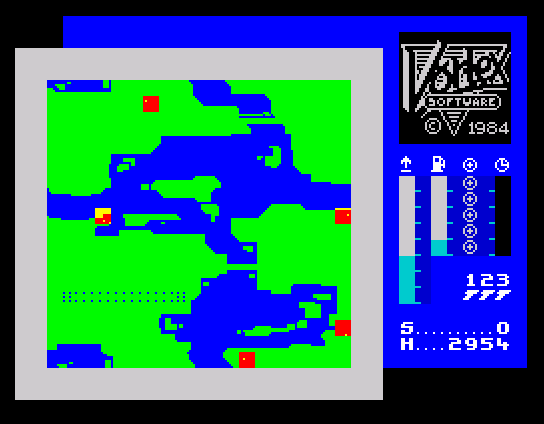
You start on the runway and press the fire button to launch your plane forward and take off. Up and down keys control your height, while left and right rotate the Tornado... errr... well, left and right.
Pro tip: wait a few seconds on the runway for your plane to fuel up before taking off. Unless you want to look like an enormous fool as you career into the landscape shortly afterwards, due to an empty fuel tank. And yes, I did it, multiple times.
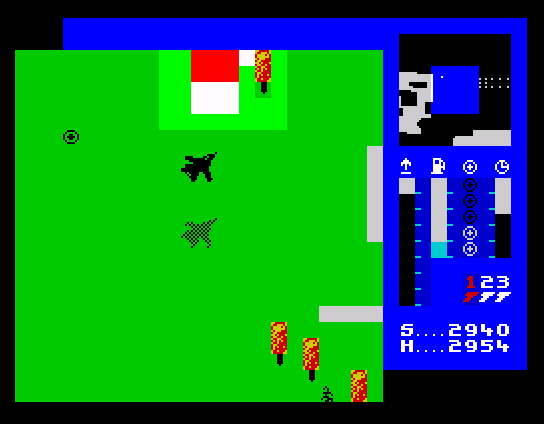
Your fuel drains rather quickly but can be topped up if you land on the runway. Landing is a delicate affair but easy enough with a bit of practice. There's also a time limit for destroying the five bases. This drains a bit more slowly than fuel, and I found this was nicely balanced, forcing you to make decisions about whether to refuel or to charge straight for your final base.
A standard tactic once you find a base is to slowly descend whilst circling (where there's space to do so safely), tweaking your position until your plane moves over the base. While flying, pressing FIRE toggles your plane's wings between flat and 'streamlined'. This affects your speed and manoeuvrability, including turning circle size. It also makes your engine noise a bit quieter, which is a nice touch.
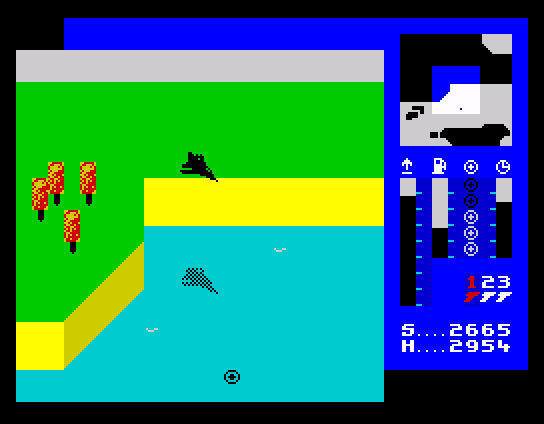
Aside from the fuel/time constraints, your only other hazard is crashing into scenery as there are no other hostile planes. Flying at maximum altitude will let you avoid most of the scenery, though there are a few structures that are tall enough to cause problems.
However, the main challenge is manoeuvring your plane low enough to the ground to hit the bases, especially where they're not in an open space. Your route to the base is usually easy enough to figure out, but takes skill to execute efficiently, particularly with fuel and timer ticking down.
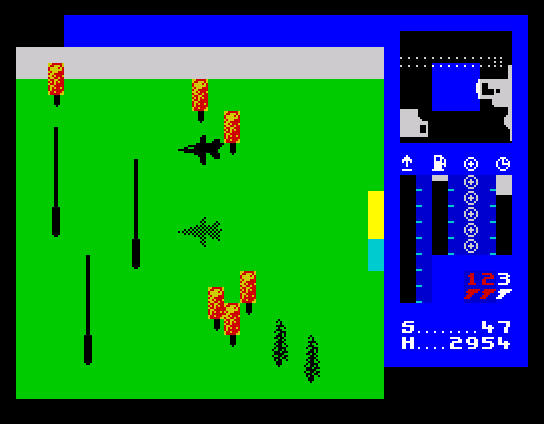
Once you destroy all five bases, you need to re-land your plane on the runway. Or just crash if you want, but you'll lose one of your three lives. You're then presented with another set of base locations for the next round.
Aside from base placement (varying between very easy and slightly fiendish), the game is largely a high score challenge, as no additional or different game elements are introduced to the player. But just flying around is an enjoyable experience, and practising aerial manoeuvres and landing on the runway is fun and helps you quickly increase your skill level.
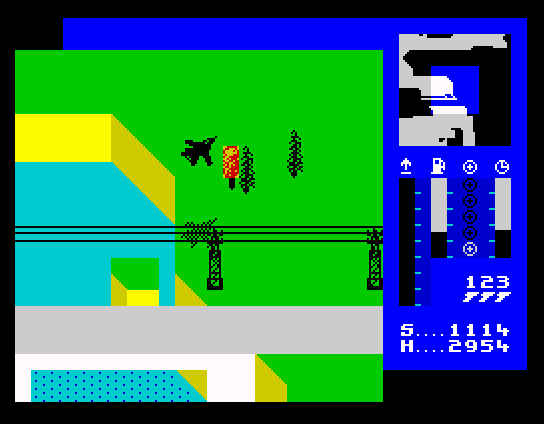
Summary
This game appeared during the early-to-middle age of Speccy games - a time when many programmers were shifting from arcade clones and had started to get imaginative in both their vision and programming. The easy-to-learn, and nicely-balanced gameplay of T.L.L. is testament to Costa Panayi's ability as a canny game designer, as well as his obvious programming ability.
I'd wager that a new gamer will probably get to the point where they destroy a round of five bases within an hour or so of playing. If I were to offer a criticism, I'd say that aside from the random base placement there's nothing new offered to the player in terms of maps or additional challenges.
However, the beauty of having a small, single map (which wraps around) makes the landscape learnable. This lets you see your performance improve in each round you play, which is the sign of a well-designed game. And its simplicity has had me coming back for a quick go on multiple occasions.
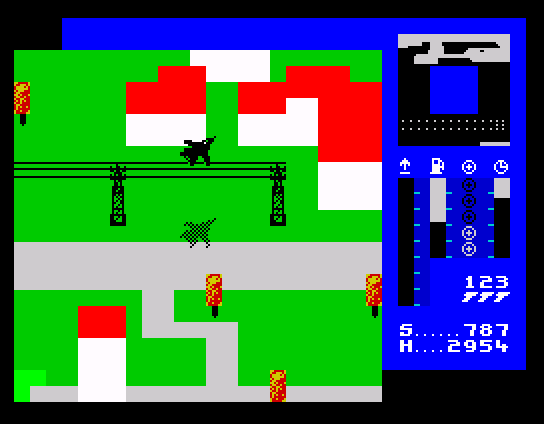
Reception at the time? Well, the main mags liked it. It was awarded 8 out of 10 in the Sinclair User review. In the Crash review it may have received a Crash Smash if one reviewer wasn't a bit lukewarm in their assessment.
Not that it really matters. T.L.L. has worked its way into many 'top 100 Speccy games' lists, and added to the ensemble of offerings that further cemented Costa Panayi's reputation as one of the big hitters in Speccy arcade history.